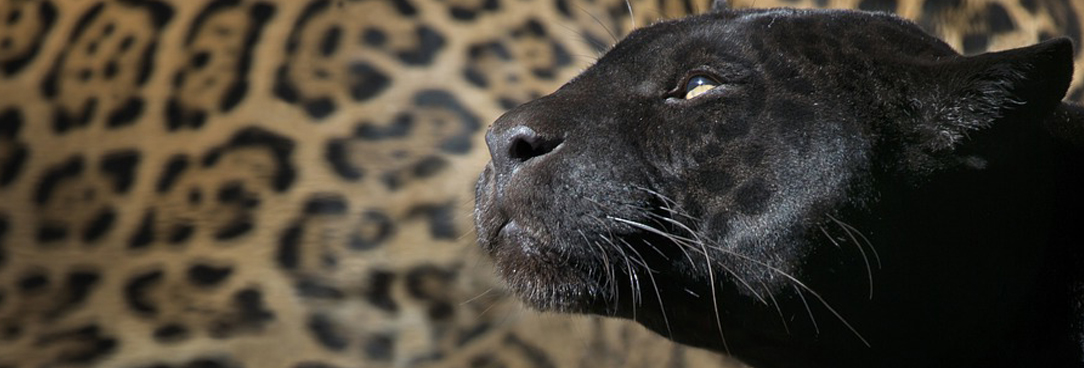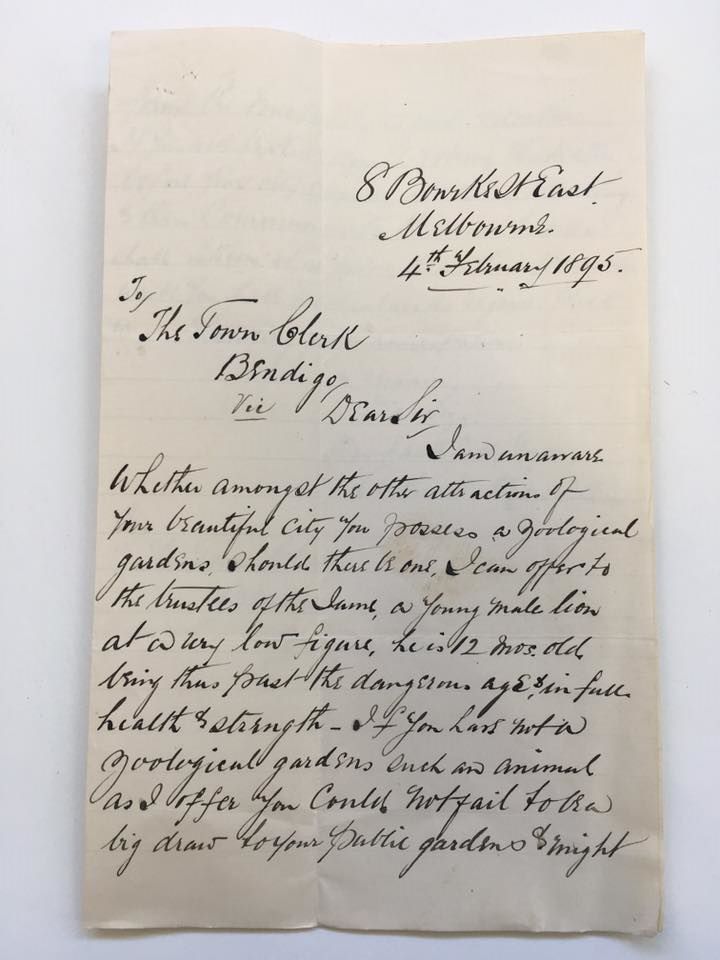Author: Desiree Pettit-Keating
Bendigo Regional Archives Centre Achives Officer
On a Thursday in late January, sisters Alheith and Trine Christensen were driving through the Whipstick to the family farm at Kamarooka. Climbing a crest some 18 miles north of Bendigo, they saw what they thought to be a fox atop the hill. The animal appeared to have no fear and approached their buggy.
The women described the animal as three-to-four feet in length with a long tail, thick neck and head, like a cat about the nose but more oblong, about 24" tall with a glossy brown body and lighter undercarriage, and walking “in a sneaking attitude and gait peculiar to that species”i.
After that sighting – which was widely reported in Melbourne and interstate newspapers – other people stated that they too had seen a strange animal in the scrub at different times over several monthsii.
The sisters, aged 23 and 29 at the time, were convinced that they had faced a pantheriii. Could they be classed as credible witnesses?
The Christensen sisters
The daughters of Scandinavian farmers, a look in the PROV archives shows that both women (along with a third sister and a brother) were school teachers.
In fact later the same year, Alheith was promoted from the Patho State School to the Rochester State School after just one term, described as a teacher with few equals, with her scholars sweeping prize lists at all competitions where they were virtually unbeaten. Such was the regard for her ability in tuition that the Patho school community put on a farewell social where they presented her with several gifts, including a dagger brooch set with pears and rubiesiv.
She had started as a teacher in 1892, becoming certified in 1898; the inspector’s reports (found in the Teacher Records) describe her as “most careful and painstaking”, a “very good teacher”, “rigorous” and “thoughtful and intelligent”, while Trine, starting later in 1898, is noted by inspectors as careful and hard workingv.
Perhaps the sighting by a pair of sober, educated women had some merit?
A big dog or cat of a strange variety
By early Februaryvi, a party had been organised to scour the scrub, with people theorising that the animal was in fact a “big dog of a strange variety”, or a panther escaped from a circus which camped near Kamarooka for several days twelve months’ earliervii.
As time wore on, more people claimed to have seen the animal, reported as becoming “more and more daring”viii. An unnamed lady was driving a pair of horses to Bendigo and was chased for a mile by the beast. She returned home via another road to avoid it. Others said that it was too big for a panther and was shaped and marked more like a tiger.
Other reports even suggested that the panther was one and the same with another notorious creature – the Tantanoola tigerix. By mid-February, travellers on the Bendigo-Kamarooka Road were carrying firearms to counter the at-large animalx.
There are no mentions of the panther in the minutes books of either the Shire of Huntly or the Shire of East Loddon, no letters demanding action or hunt initiatives. Perhaps this is because by March, the panther mystery seemed to have been solved.
Panther mystery solved?
An orchardist living at Epsom-Huntly had a “big and most peculiarly marked dog”xi that some weeks earlier had broken it’s chain and strayed. The story provided a handy metaphor for journalists at the time however, with the Bendigo Independent comparing the tale to the efficacy of politics:
“That Tantanoola tiger or Kamarooka panther has resolved itself into a very tame and lame dog under the leadership of Mr Prendergast. Mr Nicholas Fitzgerald MLC and the rest of the liquor trade developmental and extension party in the Upper House, found that they could pat Mr Prendergast on the head and he would in the People’s Chamber help vigorously to do their work for them”xii
A comet seen in Tasmania was declared by an astronomer to have missed Earth by a thousand million miles, but many were looking for it regardless, prompting the Advocate to write:
“The comet promises to be as hard to locate as the Tantanoola tiger or Kamarooka panther and is likely to prove almost as dangerous”xiii
The "big cat" lives on
Over time, there have been several big cat sightings in the district, many seemingly encouraged by the stories of the Tantanoola Tiger in the summer of 1895. The beast was reportedly seen in California Gully (where the local constable, no less, asserted the culprit behind goat deaths was none other than The Tiger), the Prince of Wales mine in Eaglehawk (where a large dog was found to be behind the goat deaths)xiv, Myers’ Flat (seen by a “a strictly temperate” stationmaster and his young daughter)xv, Maiden Gully (where Constable O’Keefe saw a tiger at first, but later believed it was a large dog)xvi, the Kangaroo Flat Recreation Reservexvii, and Axe Creekxviii.
The Council, in the midst of the ‘tiger scare’, was offered the real deal in a somewhat unusual piece of correspondence from Bourke Street dentist, Arthur F Russell. Dr Russell, whose wife Florence was a well-known lion tamerxix, clearly had a surplus and wrote to the council offering them – at a “ very low figure” – a young male lion, in “full health and strength”, and at 12 months old, “past the dangerous age”xx.
The reaction at City Council was reported in the local newspaper – “a good deal of surprise and some amusement”, with Councillor Bailes suggesting that only the Tantanoola tiger would then be required, “…then we’ll be right.” Councillor Carolin suggested that it would be rather ambitious to start a menagerie with one lion, and the letter was simply marked as receivedxxi.
As late as 1915, a large animal reported by farmer John Comer as looking like a tiger or leopard was seen in Mandurang, coming through the scrub and then heading toward the Maloney and Semmen farmsxxii. Locals thought it may have been a pig, but Comer was adamant that the animal “walked with a stealthy, springy stride just like a tiger and was striped like that animal”.
Local superintendent of police, Arthur Dungey, was sceptical, suggesting that if the creature was the alive “it’s a very old bird by now” and that if anyone could “lay low that ferocious mythical beast of prey… he will win the undying gratitude of every member of the force!”xxiii.
There are many contemporary reports on various blogs and forums of people sighting panthers in areas such as Heathcote, Sedgwick, Harcourt, Maldon, Glenluce and Sandon – do you have modern or family stories of big cats across our catchment area?
References
i Wild beasts at large: supposed panther, Bendigo Advertiser, 21 Jan 1907, p8
ii Search for a panther at Kamarooka, The Age, 25 Jan 1907, p6
iii Supposed panther near Bendigo, The Leader, 26 Jan 1907, p24
iv About people, Bendigo Independent, 27 May 1907, p3
v Public Record Office Victoria (PROV), VA 714 Education Department, VPRS 13579 P1 Teacher Records, unit 44, 1893 & unit 46, 1897
vi The Kamarooka panther, The Age, 4 Feb 1907, p4
vii Search for a panther at Kamarooka, The Age, 25 Jan 1907, p6
viii The scrub panther scare, The Age, 2 Feb 1907, p16
ix That tiger!, The Daily Telegraph, 2 Feb 1907, p12
x News in brief, Ballarat Star, 11 Feb 1907, p6
xi The panther mystery explained, The Age, 1 Mar 1907, p6
xii Today’s election, Bendigo Independent, 15 Mar 1907, p2
xiii The erratic comet seen at Bloomfield, Advocate, 23 Mar 1907, p21
xiv The Tantanoola tiger, Bendigo Independent, 9 Mar 1895, p2
xv What was it?, Bendigo Advertiser, 29 Apr 1896, p2
xvi Was it the Tantanoola tiger?, Bendigo Advertiser, 27 Feb 1895, p3
xvii The Tantanoola tiger at last, Bendigo Independent, 23 Feb 1895, p2
xviii The Tantanoola tiger, Bendigo Independent, 9 Mar 1895, p2
xix People we know, Melbourne Punch, 25 Mar 1897, p2
xx PROV, VA 2389 City of Bendigo VPRS 16936 P1 Inward Correspondence Files, Unit 48 (1-14 February 1895), letter dated 4 February 1895
xxi A lion for sale, Bendigo Independent, 16 Feb 1895, p2
xxii Tantanoola tiger again, Bendigo Independent, 13 Jan 1915, p3
xxiii Tantanoola tiger again, Bendigo Independent, 13 Jan 1915, p3
Originally published in the Bendigo Regional Archives Centre enewsletter.


